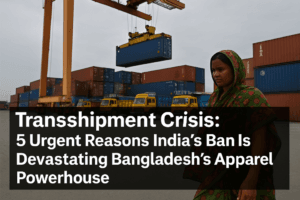Transshipment Crisis: 5 Urgent Reasons India’s Ban Is Devastating Bangladesh’s Apparel Powerhouse
Bangladesh’s garment sector, responsible for 84% of its exports, faces heightened strain as India’s ban on transshipment disrupts critical shipping routes, escalating costs and delivery timelines. Former BGMEA President Faruque Hassan urges India to reconsider, citing the move’s threat to Bangladesh’s competitiveness amid global trade volatility. With 95% of exports reliant on sea routes, rerouting through distant hubs like Singapore inflates freight costs by 15–20%, risking buyer shifts to rival markets.
Hassan emphasizes India’s role as a key supplier of raw materials, advocating reciprocity to sustain the $8 billion bilateral trade relationship. He calls for urgent infrastructure upgrades, including expanded cargo flight capacity, to reduce dependency on external ports. The appeal underscores the need for regional collaboration, warning that prolonged restrictions could push Bangladesh toward alternative partners, reshaping South Asia’s economic landscape. Resolution hinges on diplomatic dialogue balancing security concerns with mutual economic growth.

Transshipment Crisis: 5 Urgent Reasons India’s Ban Is Devastating Bangladesh’s Apparel Powerhouse
Dhaka’s garment industry, a cornerstone of Bangladesh’s economy, faces mounting challenges as India’s recent ban on transshipment for Bangladeshi exports threatens to disrupt supply chains and inflate costs. Faruque Hassan, former president of the Bangladesh Garment Manufacturers and Exporters Association (BGMEA), has publicly appealed to New Delhi to reverse the decision, emphasizing its ripple effects on regional trade dynamics and Bangladesh’s export competitiveness.
Why Transshipment Matters
Transshipment—a practice where goods are transferred between vessels or transport modes en route to their final destination—is critical for landlocked or geographically constrained economies. For Bangladesh, which relies on maritime routes for 95% of its $47 billion apparel exports, India’s ports historically provided a strategic link to global markets. The ban forces exporters to reroute shipments through alternative hubs like Singapore or Colombo, adding days to delivery timelines and raising freight costs by an estimated 15–20%.
Hassan argues this undermines Bangladesh’s cost efficiency at a precarious time: “Global retailers are already grappling with inflation and U.S. tariff hikes. Increased lead times and logistics expenses could push buyers toward competitors like Vietnam or Cambodia,” he warned.
Garments: The Lifeline of Bangladesh’s Economy
The apparel sector accounts for 84% of Bangladesh’s total exports and employs over 4 million workers, predominantly women. With orders from the U.S. and EU—its largest markets—already under pressure, Hassan stressed that losing transshipment flexibility erodes the industry’s agility. “Every dollar added to production costs impacts our ability to retain orders and invest in sustainable practices,” he noted, referencing the sector’s push toward eco-friendly manufacturing to align with global trends.
India-Bangladesh Trade: A Delicate Balance
While Hassan acknowledged India’s role as a key supplier of raw materials (textiles, dyes, and machinery account for $8 billion in annual imports), he urged reciprocity: “Trade partnerships thrive on mutual benefit. Restricting transshipment contradicts the spirit of regional cooperation.” India’s decision, reportedly tied to security concerns over smuggling, has sparked debate among analysts who view it as a setback for South Asian economic integration.
Seeking Solutions Beyond Diplomacy
Beyond urging dialogue, Hassan called for Bangladesh to bolster its infrastructure. “We need immediate investments in cargo flight capacity and port modernization,” he said, pointing to Dhaka’s underutilized airports. Expanding air freight options could reduce reliance on maritime transshipment altogether.
The Bigger Picture: Regional Solidarity in a Fragile Global Economy
The appeal underscores a broader reality: South Asia’s economies are deeply interconnected. India’s exports to Bangladesh have surged in recent years, driven by demand for machinery and raw materials. Restricting trade facilitation mechanisms risks destabilizing this synergy. As Hassan concluded, “Political differences shouldn’t derail economic progress. We share a border, history, and future—let’s prioritize collaboration over barriers.”
What’s Next?
The ball now lies in India’s court. Reviving transshipment access could reinforce trust and unlock opportunities for joint ventures, such as shared logistics hubs. Conversely, prolonged restrictions may push Bangladesh closer to alternative partners like China, reshaping regional trade allegiances. For now, Dhaka’s apparel sector remains hopeful diplomacy will prevail—but the clock is ticking.
You must be logged in to post a comment.